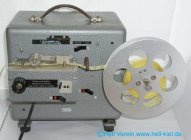| Morse Transmitter MG 23 (1950) | |||||
|
These devices were mainly used for learning and exercising the Morse code. The Morse transmitter sends the Morse codes punched into a Wheatstone paper tape over a transmission line or over a radio channel to a receiver which records the transmitted Morse codes. The holes punched into the tape are sensed by feeler levers, which close an electric contact when they sense a hole. By means of a relay circuit it is detected, whether the two holes are one above the other or are separated by one position.
|
|||||
|
Accordingly, a contact is switched on for a short or long time, via which either direct current
signals are sent, e.g. to the UR39 recorder, or which controls a connected tone generator
from any manufacturer with a headphone connection.The transmission speed can be adjusted
between 60 to 220 characters per minute. In addition, the pause between the characters can
be adjusted up to 7 times the normal length, so that it is made easy for beginners to learn the
Morse codes, when they listen tothem by means of an earphone or a loudspeaker. Since only
the pause is made longer and not the timing of dots and dashes within a character, the sound
impression of a character does not change.
The Morse transmitter was not only used for learning and exercising, but also for regular trans- |
|||||
|
Catalogue ; 1963 ; 4 pages ; 1,1 MByte ; German
Catalogue ; 1973 ; 4 pages ; 1,0 MByte ; German
Operating manual ; 1959 ; 26 pages ; 4,2 MByte ; German
|
|||||
|
|||||










